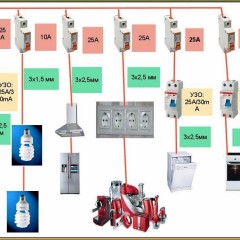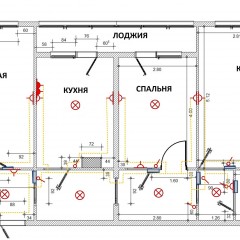How to conduct electrical wiring on the floor without breaking the rules
Weigh “FOR” and “AGAINST”
First, let's talk about the advantages and disadvantages of installing wiring inside the floor.
Among the advantages of this type of wiring are:
- Wiring Safety. If you decide to install electricity under the floor, it is unlikely that you will accidentally hammer a nail into a cable or inoculate current-carrying conductors with your puncher.
- Profitability. The debatable question is between the high cost of money for installing electrical wiring in the floor, and, conversely, the profitability of this idea. The pluses include significant cable savings, as it will not stretch around the perimeter of the room (along the walls from one to another), but under the screed, along the shortest path to sockets and switches, as shown in the photo. Please note that the cabling in the floor is economically justified mainly when the sockets are located at a height of 20-30 cm from the floor.
- Ease of electrical work. With the exception of pouring screeds, you do not have to do anything complicated. All that is needed - thread the cable into the corrugation or pipe, securely fix the wiring on the floor and bring all the ends to the "electrical points" for connection.
As for the minuses, the negative sides of the installation of wiring under the floor are:
- The complexity of repairing and replacing wiring. If a chain break occurs (due to a rodent, marriage, or installation damage), the problem area cannot be found. All you can do is pull out the cable and replace it with a new one, and then if before that the installation was done in a corrugation of a sufficient diameter or in pipes.
- Increased purchase costs corrugations and repair of the flooring (if suddenly a concrete screed has to be broken to access the damaged area).
As you can see, there are both positive and negative sides of the cable laying under the floor, so you need to seriously weigh all the pros and cons before conducting the wiring under the floor.
Where is better to use?
There are two situations where it is advisable to install wiring in the floor. The first is if you bought an apartment in a new building. Very often, developers rent residential premises without repair, in which all electrical wiring is laid out in corrugations on the floor, as in the photo below.
To not perform laborious wall chipping, you can simply fill in the screed and remove the cable to connect to all outlets and switches.This solution to the problem has a very significant advantage - you can hide the cable and lead it exactly to the right place, without violating the integrity of the walls.
The second situation is more relevant. At installation of electrical wiring in a wooden house you have to choose: either do retro wiring, the cost of which is much higher. Or carry out cable routing in special cable channels, which do not complement the interior of wooden private houses very well. So, the electrical wiring in the floor allows you to “kill two birds with one stone”: hide the cable under the wooden floor and at the same time conduct electricity to all the necessary areas of the rooms.
Installation Rules
So, we come to the most important part of the article, in which we will tell you how to conduct electrical wiring in the floor yourself. To make electricity in a private house or apartment safe, consider the following standards and recommendations for electrical work:
- Under the concrete screed, the cable is laid in the corrugation or steel pipe, the latter option is especially suitable for wiring under a wooden floor. In any case, the best solution for protection against ignition and against rodents is a steel pipe. When mounting behind coatings of combustible materials and on them, use only cables with a sheath of non-combustible materials, such as VVGNG-LS.
- There should not be any twists in the floor. All electrical wire connections must be in junction boxes led above the floor. If this rule cannot be fulfilled, make a switch box with an inspection cover in the floor. Be sure to mark this place on the diagram so that in the future you can quickly find this electrical unit.
- When laying the wire in the floor, the corrugation should be filled no more than by 35-40%, according to the PUE p. 2.1.61 (Chapter 2.1 PUE).
- The number of turns is not regulated by regulatory documents, but keep in mind that if you want to replace the cable in the corrugation, then even with 2 turns at 90 degrees it will be very difficult to do this.
- If you decide to conduct wiring on a wooden floor, you do not need to do this directly on the lags. It is better to create special technical holes through which pass the corrugation, as shown in the photo.

- When installing electrical wiring under a wooden floor, be sure to treat the wood with anti-burning products.
- The thickness of the screed over the corrugation should be at least 30 mm.
- Try not to overlap the tracks (intersection), as in this case, you will have to increase the thickness of the concrete screed for wiring in the floor.
- Even when laying in the corrugation, cable transitions through walls, partitions, logs, etc., are carried out in metal sleeves (pipe sections), in extreme cases - in plastic.
Given these rules and regulations, you can easily make safe wiring under the floor. The procedure can be different: either you first create a network of pipes into which you will then extend the cable, or you will immediately install the routes with the cable inside. The main thing, consider the important point - before pouring a concrete screed or stuffing boards on the logs, check the ready power grid with a multimeter for short circuit and cliff. If you did everything correctly, you can proceed to laying the flooring and connecting sockets, switches, lamps.
That's all I wanted to tell you about how to make electrical wiring in the floor with your own hands. As you can see, this wiring option has both advantages and disadvantages. If you install suspended or suspended ceilings - it will be more practical and maintainable to lay the wiring on the ceiling.
Similar materials:









Alexander correct the article which is misleading. Referring to PUE 2.1.61, you were not careful, and it is not applicable for hidden wiring; this section refers to open installation. The minimum thickness of the screed over the overlap of highways 20 and not 30mm. And if this is not possible, then it is possible to additionally provide isolation from mechanical damage, this is also all spelled out in the PUE. Check the information before you go to the masses. Please correct the article. Basically, that's right.
Hello! Referring to this point, we would like to say that readers do not stuff the corrugation with a cable bundle to failure. In this case, tell me and confirm with reference the document where to study the requirements for laying concealed wiring in the corrugation, well, is it possible to lay several cables in one pipe, etc.?